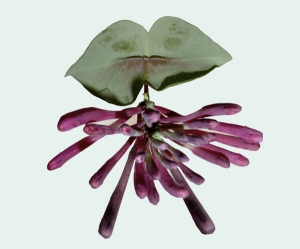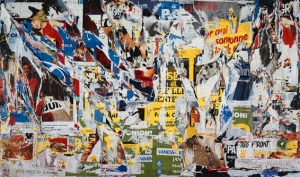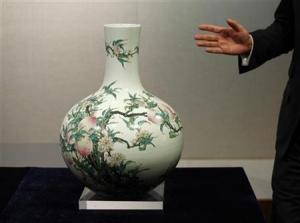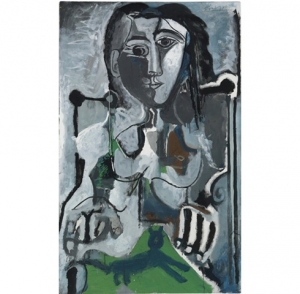|
Displaying items by tag: Contemporary Art
Fall may have just begun, but Art Basel Miami Beach is already gearing up for December. The mother of all American art fairs has compiled its exhibitor list for its 11th edition, which runs December 6-9. Over 680 galleries competed for 257 spots -- slightly fewer than last year's total of 264. They hail from 31 countries and include new faces from New York, Paris, Berlin, and London. Meanwhile, some familiar dealers -- including Tony Shafrazi, Zach Feuer, and Marc Jancou, all of New York -- will not be returning.
The Museum of Contemporary Art Los Angeles isn’t in a party mood this year.
The downtown institution, rocked by the departures of board members, won’t hold a gala in 2012, according to an e-mail from the museum. Past events have included performances by Lady Gaga, Beck and Deborah Harry.
The annual soiree, usually held in November, has been the museum’s largest annual fundraiser, tax filings show. The 2011 gala, which raised $2.5 million, was directed by performance artist Marina Abramovic and featured live nude models rotating on tables, while guests including Pamela Anderson, Kirsten Dunst and Will Ferrell dined in white lab coats.
“This year’s MOCA gala is scheduled for the spring,” according to the e-mail from the museum. “Date to be announced shortly.”

Contemporary art is occupying hallowed halls this season: Andy Warhol at the Met, Matthew Barney at the Morgan Library.
And Conceptualism, which 40 years ago proposed trashing museums altogether, is now assuming old master status in them. It’s even getting a historical survey in “Materializing ‘Six Years’: Lucy R. Lippard and the Emergence of Conceptual Art,” a show that opens at the Brooklyn Museum on Friday and provides the back story for a surprising number of other shows, mostly of new art, coming in the months ahead.
Not that the Brooklyn exhibition has blockbuster potential; if anything, the opposite is true. It’s a compendium of archival odds and ends: postcards, snapshots, arcane pronouncements. And it’s based on a 40-year-old scrapbook of a book with an interminable art-speak title, of which “Six Years: The Dematerialization of the Art Object from 1966 to 1972: A Cross-Reference Book of Information on Some Esthetic Boundaries” is just the first quarter. Compiled by Ms. Lippard, a pioneering feminist writer and curator, and published in 1973, the book remains a founding document of a hugely influential kind of art that emerged from an era of social upheaval and that spurred far-reaching changes in thinking about what art could be — meaning, among other things, unheroic, non-Western, female, ephemeral.

Think contemporary art in France and it is Paris’s still radical-looking Centre Pompidou that springs to mind. But for all Beaubourg’s status as a cultural powerhouse, the French have been anxious not to neglect their regions. In the past 30 years state-funded collections of contemporary art have quietly sprung up across France, bringing big-name artists such as Cindy Sherman and Sophie Calle to remote corners of the country, from Brittany to Provence.
The Fonds régionaux d’art contemporain (regional contemporary art funds, or Frac) were initiated by culture minister Jack Lang in 1982 as part of a decentralisation plan, the aim being to present the artists of the day to a diverse public in a spirit of fraternité. Now numbering 23, Frac are present in every French region, with more than 26,000 works by 4,200 French and international artists comprising the third largest public collection of contemporary art in France (behind the Paris-based Cnap, the Centre national des arts plastiques, and the Pompidou’s Musée national d’art moderne).
It is considered one of the most important contemporary art collections in the world, featuring Tracey Emin’s bed and Grayson Perry’s pots.
So when Charles Saatchi offered to donate the cream of his private collection – valued at upwards of £30 million – to the nation for free, he might have been forgiven for thinking it would be gratefully accepted.
But two years since announcing his generous gift, the collection has yet to find a home.
Instead, the Government has bungled attempts to secure it while a national museum has also passed on the offer.
Saatchi’s bequest includes more than 200 works by several of the world’s leading contemporary artists, among them Jake and Dinos Chapman, the Indian artist Jitish Kallat and Emin, whose unmade bed, My Bed, which came to symbolise the Young British Artist (YBA) movement of the 1990s, is included.
When John Baldessari was looking for an L.A. gallery to show his work 20 years ago, he narrowed his choice to three and ultimately chose Margo Leavin.
"I thought she would be around for a long time," he said. "And it turned out to be true."
For more than four decades, Leavin has occupied a prominent perch in the Los Angeles contemporary art scene. Her gallery, which opened in 1970, is one of the most enduring and recognizable in the city, with a roster of top-tier artists that includes Jeffrey Vallance, Alexis Smith and William Leavitt as well as Baldessari.
Billionaire philanthropist Eli Broad hasn’t made scheduled payments to the Museum of Contemporary Art in Los Angeles because the institution has $2.1 million in grants it hasn’t put toward exhibitions.
“Once our unspent exhibition funds have been used, we will make additional payments,” said Karen Denne, spokeswoman for the 79-year-old founder of KB Home (KBH), in an e-mail.
The missed payments come at a time when concerns over finances at the museum have resurfaced after four prominent artists quit MOCA’s board last month.

The contemporary-art market surged by 35 percent in 2011’s auctions as an influx of wealthy buyers sought refuge from financial turmoil.
Sotheby’s (BID) and Christie’s International raised a combined total of $1.7 billion from evening sales, according to calculations by Bloomberg News. Collectors sought proven artists for investment, led by Germany’s Gerhard Richter, 79.
While some prices are still below the highs of September 2008, when Lehman Brothers Holdings Inc. collapsed, buyers from the U.S., Russia, Asia and other emerging economies have been investing in contemporary art.
“The art market is a place for new people these days,” Christophe Van de Weghe, a New York-based dealer, said in an interview. “There are Americans nobody has seen before who are excited by this world and who want an alternative to shares. And then there are buyers coming in from places like India and China. The collectors who bought 15 years ago aren’t prepared to pay today’s higher prices.”
Sotheby’s and Christie’s made their combined total with fees from 12 high-value contemporary art sales in New York and London this year. In 2010, the equivalent evening auctions made $1.2 billion, an increase from $482.3 million in 2009. The sales reached a record $2.4 billion in 2007, fuelled by speculative bidding for fashionable names such as Damien Hirst, Jeff Koons and Richard Prince.
Market Demand
“The market is hungry for great works at ‘masterpiece’ level,” the New York-based art adviser Mary Hoeveler said in an interview. “There is tremendous wealth to buy them. New buyers are also migrating to the contemporary market from other more traditional art collecting fields. Demand for contemporary art has increased exponentially.”
Sotheby’s raised $844.1 million from its evening auctions in 2011, while Christie’s took $834.3 million. Equivalent auctions in New York and London held by Phillips de Pury & Co., which has a reputation for offering pieces by emerging artists, totaled $208.3 million, an increase of just $7 million on 2010, according to Bloomberg calculations.
Classic contemporary works from long-established collections attracted intense demand. Sotheby’s sale of 34 paintings by Georg Baselitz, Sigmar Polke and other German artists belonging to Christian Graf Duerckheim-Ketelhodt, chairman of the Cologne-based pharmaceutical company Axiogenesis AG (AI8), raised 60.4 million pounds ($94.6 million) in London on June 29. The total with fees almost doubled the low estimate of 31.8 million pounds, based on hammer prices.

The Asian art market juggernaut showed signs of weakness on Monday in Sotheby's sales of Chinese 20th century and Asian contemporary art as global stock markets plunged on a darkening global economic outlook.
Sotheby's biannual Asia sales in Hong Kong, the world's third largest art auction hub after New York and London, are a closely watched barometer of art and luxury market sentiment for its array of offerings spanning Chinese antiques to fine wines.
While prices were still strong for early masterpieces from prominent artists like Zhang Xiaogang, mid-tier works struggled to find buyers with 27 percent of Asian contemporary works and 22.6 percent of the 20th century Chinese art work failing to sell on tepid bidding.
On Sunday, auction room sentiment for the feted Guy Ullens collection of contemporary Chinese art was noticeably cooler than April when the first batch of the Belgian tycoon's works raked in $54.8 million with a sprinkling of record prices.
While the 91 pieces were considered inferior to the April offerings from Ullens, including more experimental conceptual and installation works produced in China in the pivotal 90s, the recent market turmoil weighed on buyer sentiment.
"It'll be the same in New York. The top lots will fetch crazy prices and the average ones will sell poorly," said Edouard Malingue, an Asian art dealer.
"If you focus on medium quality, mediocre quality then I would be worried," added Malingue.
The top lot in the Ullens sale was Zeng Fanzhi's "Mask Series 1998 No. 26" that sold for $2.6 million.
In Monday's sales of over 300 works of contemporary Asian art and 20th century Chinese paintings, the plunge in the Hong Kong stock market to a 2-and-a-half year low and a darkening global macroeconomic outlook weren't lost on some buyers.
Lesser works by blue-chip artists Yue Minjun and Zeng Fanzhi failed to sell, even though estimates were seen as reasonable.
Yet Jeffrey Yu, a veteran Taiwan collector who described the mood as "very calm," still expressed frustration at the lingering buying power of Chinese dealers and art investment syndicates in snapping up major works including a Zao Wou-ki abstract canvas "10.1.68" that made HK$68.9 million ($8.9 million) and a 1931 Sanyu "Reclining Nude" for HK$16.3 million.
"We just couldn't chase the price said Yu, who bid up to HK$10 million for Wu Guanzhong's "Versailles" before giving up.

“Contemporary art costs real money now,” said dealer Nick Acquavella at Marion Maneker’s “Artelligence” conference, Sept. 21, 2011. “It’s not like browsing through SoHo on a Saturday afternoon with your checkbook anymore.” Indeed, the panel, speaking to some of the art world’s highest rollers in the main dining room of the New York Athletic Club, was in agreement that blue-chip modern art is the safer investment: it’s often considered a hard asset and the best way to hedge against inflation in a changing economy.
The all-day event, produced by Maneker and his blog Art Market Monitor, featured presentations on “art as a family asset,” “insurance for art estates” and a “Picasso market report,” but “Inside the Modern Market” with Helly Nahmad (Helly Nahmad Gallery), Guy Bennett (Marshall Holdings), Nick Maclean (Eykyn Maclean) and Acquavella (Acquavella Gallery) may have been the highlight of the day. For those who didn’t want to cough up the $500 for a ticket, here’s what happened:
Is Miró the next Picasso?
The gap between the contemporary and the Impressionist and modern art markets is shrinking, said Bennett -- “the bookends are moving.” Collectors are increasingly interested in contextualizing their works by reaching further into the future or the past, with some contemporary buyers stretching back to, say, Paul Cézanne. The ongoing craze for late works by Pablo Picasso might be one indication of this shift, which looks like it could extend for late works by Jean Dubuffet and Joan Miró as well.
“Miró is one of the most undervalued of the 20th century masters,” Nahmad proclaimed, reminding some listeners of the masterful Miró show he mounted in his booth at Art 39 Basel in 2008. “We have yet to see a $100 million Miró like we have with Picasso or Alberto Giacometti.” But that may change as well, he predicted. For one thing, the Tate Modern just closed an exhibition of 150 works by the Surrealist artist, his first major retrospective in 50 years, and it’s scheduled to travel to the U.S. next.
Miró’s later works have inspired renewed interest, Maclean said, because the supply has been so limited. “We haven’t seen Miró because great Miró hasn’t come up to the market,” added Nahmad. “People are forced to look at other works that are available.” This means that collectors who normally don’t want late-in-life paintings (many avant-garde artists are thought to fall off with age) are reconsidering. After all, according to Nahmad, cashing in on his famous name was “not the case with Miró,” adding that the artist’s late output, like Picasso’s, is considered to be some of his most mature and intellectual.
Finally, Acquavella added that Miró is particularly promising because his work appeals to those collectors with more contemporary sensibilities. “His use of collage can appeal to someone who likes Robert Rauschenberg or Jasper Johns,” he said. And his use of feathers, like in Spanish Dancer, 1928, reminded Acquavella of Damien Hirst’s butterfly collages.
|
|
|
|
|